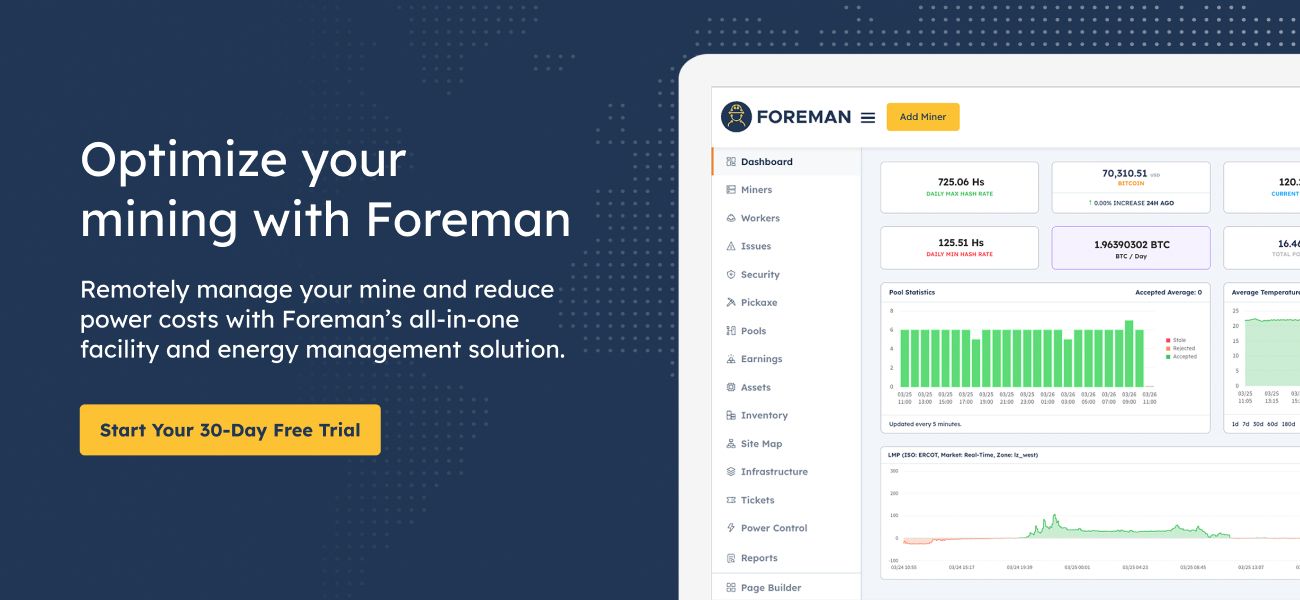As a deregulated market, ERCOT enables consumers to access free market electricity rates and take advantage of arbitrage opportunities in real-time to optimize their electricity. But how can someone utilize fluctuating power prices to maximize profitability during a volatile weather event without Demand Response?
The analysis will walk through what it would have been like for a miner to implement Peak Avoidance (otherwise known as "peak shaving" or "load shedding") using two case studies of a theoretical 10MW facility equipped with S19j Pro Miners operating at 100Th/s and consuming 3050kW in ERCOT.
The below study shows how a customer utilizing Foreman and our automated, strike price-based curtailment (peak avoidance) saved up to 90% of costs over the week of the winter storm. This study does not include any payback a power consumer would receive from Demand Response, or any benefit from selling back to the grid. It is only cost avoidance.
Electricity Cost and Storm Overview
Between December 20th and 29th, 2022, ERCOT saw substantial price fluctuations during the freezing winter storm. On a typical day, real-time electricity prices fluctuate between $25 and $35 per megawatt hour. Over this week, however, temperatures were uncharacteristically below-freezing, driving up demand for heating nationwide, and prices in EROT reached as high as $4,000/MWh and as low as $-(20)/MWh across all ERCOT zones on average.
The sizeable upward spike was driven by high demand. At the same time, the drop to negative electricity prices occurred due to an excess of electricity.
Break-Even Point
Before delving into the case studies, it is worth noting that every miner has a break-even point, where revenue equals costs. Anytime the cost exceeds the revenue, they're mining at a loss. The below graph shows this calculated price point measured in MWh. The break-even point on this graph is the revenue per MWh. Every yellow and red bar is one hour of mining at a loss.
The below graph is in log form. The empty spaces were when electricity costs went negative.
Mining Through the Winter Storm
Case study #1: cumulatively mining throughout the week of the storm without implementing peak avoidance. Each bar is one hour, and the profits made are added into a total showing the end-of-week profits.
The average revenue for these machines was around $82/MWh, and at a 10MW facility, that is $820 per hour. But when the electricity cost passed the breakeven point, the cumulative profit dropped extremely quickly, losing close to $50,000 in two hours, almost $80,000 total.
There would be no profitability when mining through the storm with real-time pricing in ERCOT at 100% uptime. And the time it took to lose all profit would happen over two hours, and one would then need to recover those losses over the next few days. It is not the ideal scenario for a miner to knowingly mine through a loss, but missing price windows is a significant problem. If curtailing isn't automated when prices spike, shutting down miners quickly can be tricky and easily missed.
Foreman allows miners to set a strike price, enabling automated curtailment, which shuts down the mine whenever profitability goes negative.
Automated Peak Avoidance
Case study #2: a miner utilizing a technique called “Peak Avoidance.” The below graph excluded all points when there was negative profitability and cumulatively stacked profits over that week.
Peak Avoidance is an automated response to unprofitability. Foreman customers calculate their specific strike price (break-even point). When electricity prices rise above that, they're automatically curtailed.
While leveraging peak avoidance, users can continuously mine while being profitable, automatically curtailing without concern and ending the volatile electricity price period in the green.
Zooming out and showing the per-hour profit can help us understand how electricity prices could affect profitability. Granted, this will be different based on the block rewards and the pool one uses, but regardless, it shows how electricity prices throughout the day affect profit.
Comparison: Peak Avoidance vs. 100% Uptime
When comparing the two studies, the Peak Avoidance strategy ended in the green with a profit of over $90,000, while the 100% uptime miner with zero peak avoidance lost all of its gains and went in the negative in only a few hours.
Visualizing this strategy makes it easier to understand how a quick response time is needed when using real-time pricing. Study 1 didn't have automated peak avoidance and lost over $100,000 in a few hours, amplifying the importance of knowing the strike price. With the capabilities of fast and responsive miners, there is no reason anyone mining on real-time pricing shouldn't be utilizing peak avoidance.
Automated curtailment through a designated strike price can mean the difference between walking away from a weather event in the green or trying to recoup the losses on the backend. These events occur regularly, where small spikes in electricity costs rise high enough to cross the profitability threshold.
Our software can avoid peak pricing regularly, letting our users automatically bear the advantage over any competitor, bringing down costs and positioning them for a more competitive advantage.

Additional Information
There are other ways to maximize cost savings outside peak shaving on electricity. These include Demand Response as a Load Resource in ERCOT and outside. Foreman partners with CSPs to help users maximize their profitability and how they interact with the Grid.

